Frost Protection - UTL Repository
Frost Protection - UTL Repository
Frost Protection - UTL Repository
You also want an ePaper? Increase the reach of your titles
YUMPU automatically turns print PDFs into web optimized ePapers that Google loves.
MECHANISMS OF ENERGY TRANSFER<br />
R n supplies energy that heats the air, plants and soil or evaporates water. In this<br />
book, the equation in Figure 3.3 is used for the surface energy balance. Note that<br />
energy storage in the plants, photosynthesis and respiration are generally ignored<br />
in vertical energy fluxes in frost protection. Assuming that all of the energy<br />
fluxes are vertical, energy from R n is partitioned into the components G, H and<br />
LE, so R n is set equal to the sum of G, H and LE (Eq. 3.1).<br />
R LE Wm -2 n = G + H +<br />
Eq. 3.1<br />
Again, the sign of the energy flux component indicates the direction of energy<br />
flow. Radiation adds energy to the surface, so it is positive to the surface. When<br />
G is positive, energy is going into the soil, and when H and LE are positive, the<br />
energy flux is upward to the atmosphere. Therefore, G, H and LE fluxes are<br />
positive away from the surface and negative towards the surface.<br />
Although, most energy transfer on a frost night is vertical, a crop is threedimensional,<br />
and energy can pass horizontally as well as vertically through a<br />
crop. Energy transfer through a crop is often depicted using an energy box<br />
diagram (Figure 3.4), which represents the volume of air to be heated in frost<br />
protection. The energy content of the box in the diagram depends on the sources<br />
and losses of energy (Figure 3.4), where most of the energy fluxes can be in either<br />
direction. The energy balance for the box is given by:<br />
R P R Wm -2 n = G + H + LE + F 1 + F 2 + ∆S<br />
+<br />
Eq. 3.2<br />
where R n is a positive number when more energy from radiation is received than<br />
is emitted and reflected, and it is negative if more radiant energy is lost than<br />
gained. The variables G, H and LE are all positive when the energy is exiting<br />
from the box and are negative if the energy is entering the box. F 1 is horizontal<br />
sensible and latent heat flux into the box (a negative number) and F 2 is horizontal<br />
sensible and latent heat flux out of the box (a positive number). The sum of F 1<br />
and F 2 is the net difference in horizontal flux of sensible and latent heat. The<br />
variable P R is for photosynthesis (a positive number) and respiration (a negative<br />
number). However, P R is small and commonly ignored for energy balance<br />
calculations. The variable ∆S is the change in stored energy (sensible heat) within<br />
the box, which is positive if the energy content increases (e.g. when the<br />
temperature increases) and it is negative when the energy content decreases<br />
(e.g. temperature falls).<br />
45


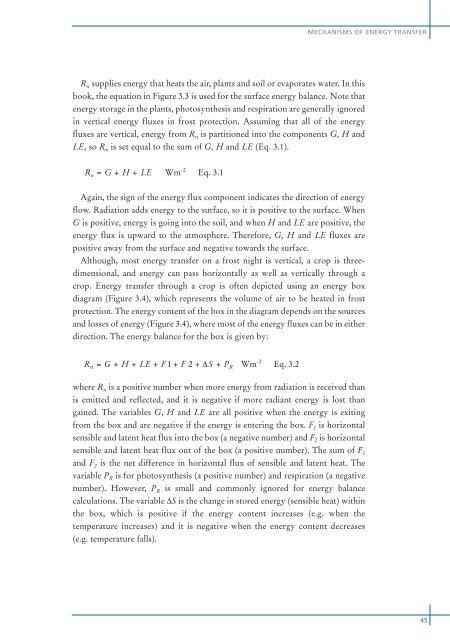
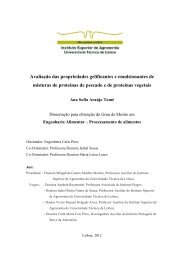
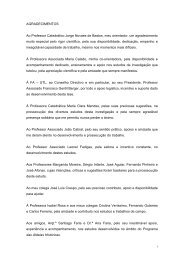

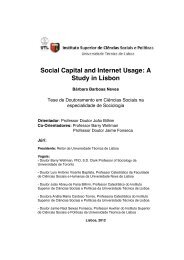
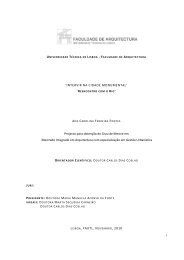
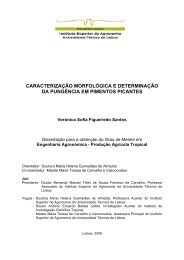

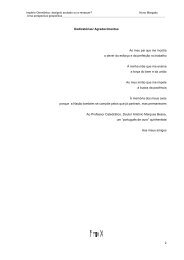
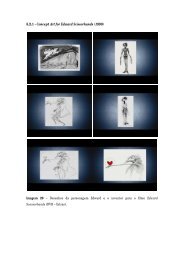
![Tese - Es..[1].pdf - UTL Repository - Universidade Técnica de Lisboa](https://img.yumpu.com/25707135/1/184x260/tese-es1pdf-utl-repository-universidade-taccnica-de-lisboa.jpg?quality=85)


